Fannie Lou Hamer
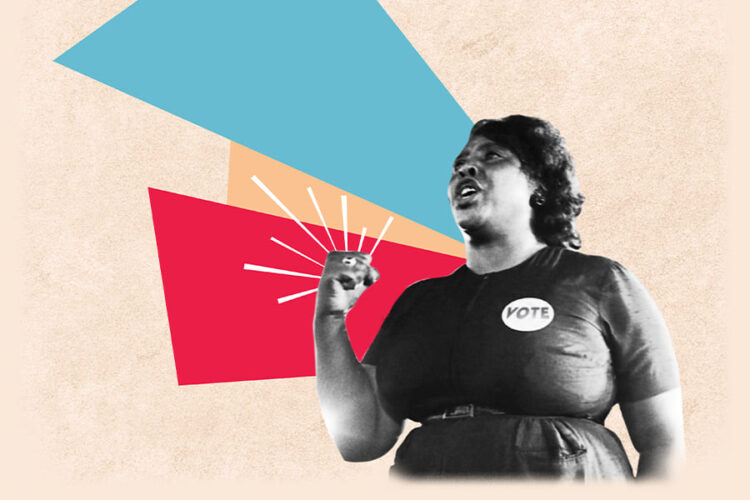
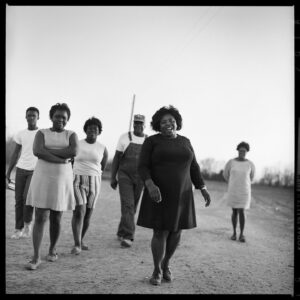

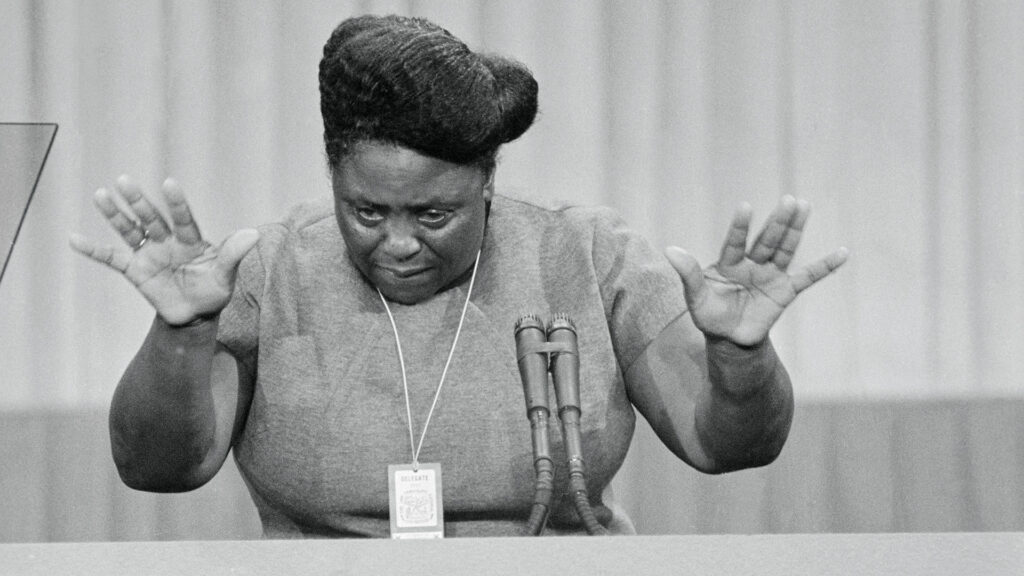

This is an image for the TV show “Fannie Lou Hamer’s America: An America ReFramed Special,” – Feb. 22, 2022, on PBS. In this photo, Hamer, a member of the Mississippi Freedom Democratic Party, enters the 1964 National Democratic Convention in Atlantic City, N.J. (CNS photo/Bettmann, courtesy PBS)
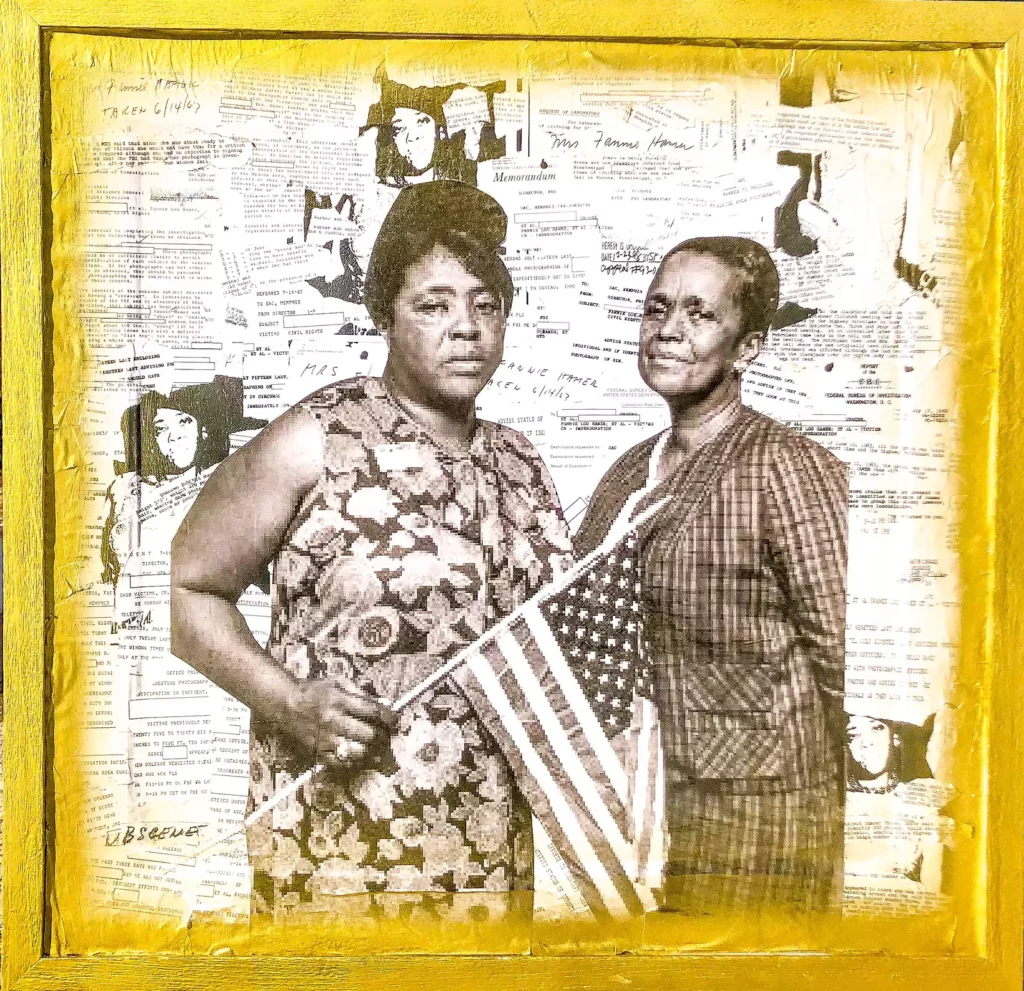
Fannie Lou Hamer and Ella Baker Intelligence Countered, (2019)
Justin Brown (Artist)
“In 1964, working with the Student Non-Violent Coordinating Committee (SNCC), Hamer helped organize the 1964 Freedom Summer African American voter registration drive in her native Mississippi.“
The Student Nonviolent Coordinating Committee (SNCC)
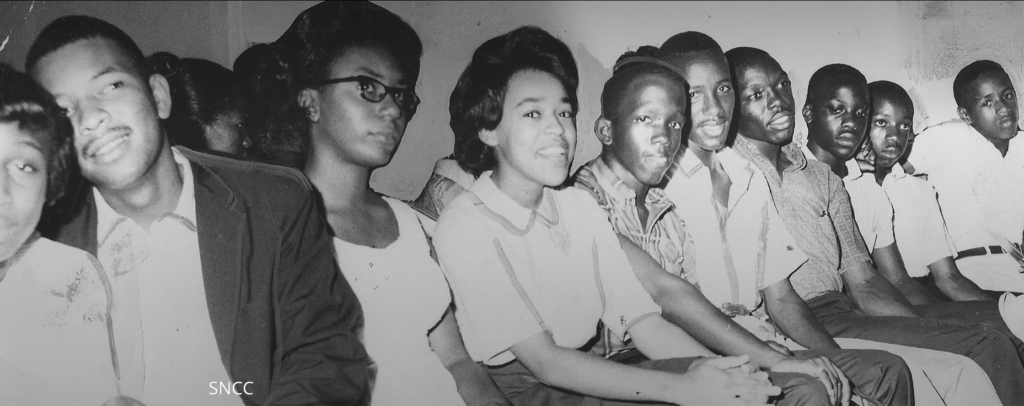
“The Student Nonviolent Coordinating Committee (SNCC) was founded in 1960 in the wake of student-led sit-ins at segregated lunch counters across the South and became the major channel of student participation in the civil rights movement. Members of SNCC included prominent future leaders such as former Washington, D.C. Mayor Marion Barry, Congressman John Lewis, and NAACP chairman Julian Bond.
SNCC Emerges From the Sit-In Movement
In February 1960, four Black college students in Greensboro, North Carolina, stayed in their seats at a segregated Woolworth’s lunch counter after the staff refused to serve them. Some 300 students soon joined their protest, which received widespread media coverage, sparking a movement of similar sit-ins by thousands of students at segregated establishments across the South.
Civil rights leaders recognized such young activists as a powerful new force in their efforts to combat racial discrimination and win equal rights for Black Americans. As the Rev. Martin Luther King Jr. acknowledged in a speech at a North Carolina church in mid-February 1960: “What is new in your fight is the fact that it was initiated, fed, and sustained by students.”
Seeking to harness the momentum of the sit-in movement, veteran civil rights organizer Ella Baker invited students who had taken part in the sit-ins to a gathering at Shaw University in Raleigh, North Carolina in April 1960. Baker had begun her career of activism as a student at Shaw more than 40 years earlier. She worked for the National Association for the Advancement of Colored People (NAACP) in the 1940s and helped King organize the Southern Christian Leadership Conference (SCLC) after the Montgomery Bus Boycott. At the time of the sit-ins, she was the SCLC’s executive director.
Founding of SNCC and the Freedom Rides
Some 200 students attended the conference at Shaw University from April 16-18, 1960, during which the Student Nonviolent Coordinating Committee (SNCC, pronounced “snick”) was born. Though King and others hoped that SNCC would function as the youth wing of the SCLC, Baker stressed the importance of remaining independent and unaffiliated with other civil rights groups.
Beginning its operations in a corner of the SCLC’s Atlanta office, SNCC dedicated itself to organizing sit-ins, boycotts, and other nonviolent direct-action protests against segregation and other forms of racial discrimination. In April 1961, SNCC activists joined a campaign launched by the Congress of Racial Equality (CORE), another civil rights group, to desegregate interstate bus transportation. Although the Supreme Court had ruled it was unconstitutional, bus travel continued to be segregated across the South.”
During the Freedom Rides in May 1961, teams of activists (many of them students) rode buses in mixed racial groups into and across the South. Diane Nash, one of the few prominent women in the sit-in movement and a founding member of SNCC, helped organize the protest and recruit riders. The freedom riders met with violent resistance on the part of local law enforcement and white segregationist Southerners; hundreds of them were arrested, beaten, and threatened with death. That November, the Interstate Commerce Commission finally mandated the full desegregation of all interstate travel facilities, giving SNCC its first solid victory on a national level.
Freedom Summer
Building on its focus on direct action (sit-ins, protests, boycotts) SNCC began working to combat one of the most difficult issues of the civil rights movement: the disenfranchisement of Black voters across the South through discriminatory voting laws, intimidation, and violence. Starting in late 1961, SNCC organizers began embedding themselves in rural communities and recruiting local young people to join in voter registration efforts.
In 1964, SNCC and other civil rights groups decided to focus their grassroots voting rights campaign on Mississippi. During Freedom Summer, hundreds of volunteers poured into Mississippi, joining efforts to increase Black voter registration and establish “Freedom Schools” for Black children throughout the state.
Segregationists in Mississippi, including both local law enforcement and white supremacist groups like the Ku Klux Klan, met the influx of volunteers with a solid wall of resistance. By the end of the summer, they had arrested hundreds of volunteers, beaten dozens and brutally murdered at least three—Michael Schwerner and Andrew Goodman, white men from New York, and James Chaney, a local Black man.
Shift from Nonviolence to Black Power
SNCC members were outraged by events at the 1964 Democratic National Convention, where the party refused to replace the all-white Mississippi delegation with one from the integrated Mississippi Freedom Democratic Party. Their anger contributed to a growing distance between SNCC and more mainstream civil rights organizations like King’s SCLC.
This divide continued after the passage of the Voting Rights Act of 1965, as some within the group began advocating for a Black-only political party in Mississippi and other more radical steps beyond nonviolent direct action. These included Stokely Carmichael, who became chairman of SNCC in 1966, replacing John Lewis. Carmichael’s use of the phrase “Black Power” during the March Against Fear, a voting rights march in Mississippi that June marked SNCC’s transition to a focus on Black self-reliance and the plight of low-income Black people living in urban centers.
Hurbert “Rap” Brown, who succeeded Carmichael in 1967, went even further down this path, forging a public alliance with the Black Panther Party. In 1968, Brown replaced “Nonviolent” in SNCC’s name with “National.” With white activists increasingly leaving the group, its income declined, forcing a reduction in direct action organizing efforts. By 1970, with the civil rights movement itself splintering into factions, SNCC had lost its employees and most of its branches. With Brown facing various legal charges, the organization struggled to survive, and by the end of 1973 SNCC no longer existed.
Sources
The Student Nonviolent Coordinating Committee (SNCC). The Martin Luther King Jr. Research and Education Institute, Stanford University.
“The Story of SNCC.” Digital SNCC Gateway.
“The SNCC Project: A Year by Year History, 1960-70.” Mapping American Social Movements Project, University of Washington.
~TIMELINE~
October 6, 1917, – Fannie Lou Townsend was born the twentieth child of James Lee and Lou Ella Townsend in Montgomery County, Mississippi.
1919 –In search of work, the Townsend family moved to E.W. Brandon’s plantation in Sunflower, County Mississippi.
1930 – Fannie Lou left school so she could help her family financially by working full-time in the fields.
1944 – Fannie Lou Townsend marries Perry Hamer and moves to the W.D. Marlow plantation, four miles outside the city of Ruleville, Mississippi.
1944-1961 – Fannie Lou and Perry Hamer adopt two children from their community, Dorothy Jean and Vergie Ree. They also care for Lou Ella Townsend, Fannie Lou’s disabled mother, while working on W.D. Marlow’s plantation.
August 27, 1962, – Fannie Lou and Perry Hamer attend a mass meeting at William’s Chapel Missionary Baptist Church. There they learn from civil rights activists that African American people have a constitutionally- guaranteed right to vote.
August 31, 1962, – Fannie Lou Hamer attempts to register to vote at the Sunflower County Courthouse in Indianola, Mississippi. Shefails the registration test. As punishment for her attempt, she is fired and evicted from the Marlow plantation upon her return home.
Fall-Winter of 1962 – Fannie Lou Hamer becomes the Student Non-Violent Coordinating Committee’s (SNCC) oldest voter registration worker. She attends workshops across the South to learn how to encourage people in her community to become politically active.
January 1963 – Passes the voter registration test on her second try and becomes among the first registered black voters in Ruleville, Mississippi.
June 1963 – Arrested in Winona, Mississippi on her return trip from a voter education workshop. She and several other civil rights activists with whom she is jailed are beaten while in police custody.
Spring of 1964 – Becomes the first Black woman to run for US Congress and the first Black person to run from her district since the 19th Century.
August 22, 1964, – On behalf of the Mississippi Freedom Democratic Party, Hamer testifiedat the Democratic National Convention about the harassment and abuse she experienced in Mississippi for trying to vote. Her testimony is broadcast nationally.
September-October 1964 – Travels to the West Coast of Africa, with other members of the Student Nonviolent Coordinating Committee, as an honored guest of the Guinean government.
December 1964 – Speaks to crowds in Harlem, New York alongside the Black Nationalist Leader, Malcolm X.
January 4, 1965, – On behalf of the Mississippi Freedom Democratic Party, Hamer, Annie Devine, and Victoria Gray challenge theseating of the five US congressmen sent from Mississippi. They argue that since black people are unconstitutionally prohibited from voting in Mississippi, the representatives do not actually represent the state and, therefore, shouldn’t be allowed to serve in the United States Congress.
April 23, 1965, – Becomes the lead plaintiff in the lawsuitHamer v. Campbell, suggesting that elections in Sunflower County should be suspended until black people are given a fair chance to register.
June 1966 – Marched alongside Martin Luther King, Jr. and spoke to protestors along the Meredith March Against Fear in Mississippi.
Spring 1967 – Fannie Lou Hamer’s eldest daughter, Dorothy Jean, dies from complications related to anemia, malnutrition, and inadequate access to health care. Fannie Lou and Pap Hamer adopt Dorothy Jean’s two daughters, Jacqueline and Lenora.
August 20, 1968, – Formally seated as a delegate from Mississippi to the Democratic National Convention, Hamer receives a standing ovation from the convention floor for her tireless advocacy of voting rights.
1968 – With the help of the National Council of Negro Women, Hamer starts a “Pig Bank” in Sunflower County to provide protein to malnourished members of her community.
1968-1972 – Fannie Lou Hamer receives honorary doctorates from numerous universities, including Columbia College and Tougaloo College. She also was named the “First Lady of Civil Rights,” by the League of Black Women and she received the “Noble Example of Womanhood” and the Mary Church Terrell Awards during this period.
1969 – With the money she raised by speaking to audiences across the country, Hamer buys the first 40 acres of “Freedom Farm,” a cooperative established to provide food and jobs for people in her community. Freedom Farm eventually grew to nearly 700 acres and became the third largest employer in Sunflower County.
July 10, 1971, – Spoke at, and participated as a founding member of, the National Women’s Political Caucus in Washington, D.C.
July 13, 1972, – Hamer is an official delegate from Mississippi to the Democratic National Convention, where she offers a speech in support of Frances Farenthold’s candidacy for Vice President.
1972-1976 – Helps secure affordable housing for people in Ruleville, while traveling nationally to raise funds for Freedom Farm and advocating for prison and poverty program reforms in Mississippi.
1976-1977 – Battles breast cancer, hypertension, and diabetes.
March 14, 1977, – Dies of heart failure at a hospital in Mound Bayou, Mississippi.
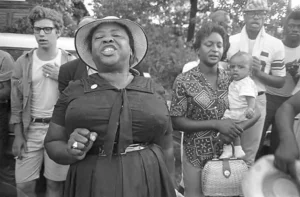

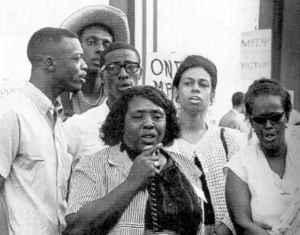
Examples of Her Legacy
July 27, 2004, – The Democratic National Convention honors Fannie Lou Hamer on the 40th Anniversary of the Mississippi Freedom Democratic Party’s Credentials Committee Challenge.
2006 – The United States Congress reauthorizes the 1965 Voting Rights Act and names it after Fannie Lou Hamer, Rosa Parks, and Coretta Scott King.
February 17, 2009, – The International Slavery Museum recognizes Hamer as a “Black Achiever” and hangs her portrait next to one of President Barack Obama in their permanent exhibit.
February 21, 2009, – The US Postal Service included Fannie Lou Hamer among twelvecivil rights pioneers were honored on postage stamps in recognition of the National Associationfor the Advancement of Colored People’s 100th Anniversary.
October 6, 2012, – In her hometown of Ruleville, Mississippi, an eight-foot bronze statue of Fannie Lou Hamer is dedicated on what would have been her 95th Birthday.
August 8, 2015, – Black Lives Matter protestors in Seattle, Washington interrupt Presidential Candidate Bernie Sanders’ political rally. The protestor who speaks to the crowd about Black Lives Matter’s concerns dons a “Fight Like Fannie Lou” t-shirt.
August 2018 – Shelby County, Tennessee Commissioner, Tami Sawyer, is sworn into office on a biography about Fannie Lou Hamer and a collection of her speeches.
Summer 2019 – The feature film,Fannie Lou Hamer’s Americaand the K-12 Find Your Voice curriculum is released on the Find Your Voice: Online Resources for Fannie Lou Hamer Studies website:www.findyourvoice.willamette.edu
